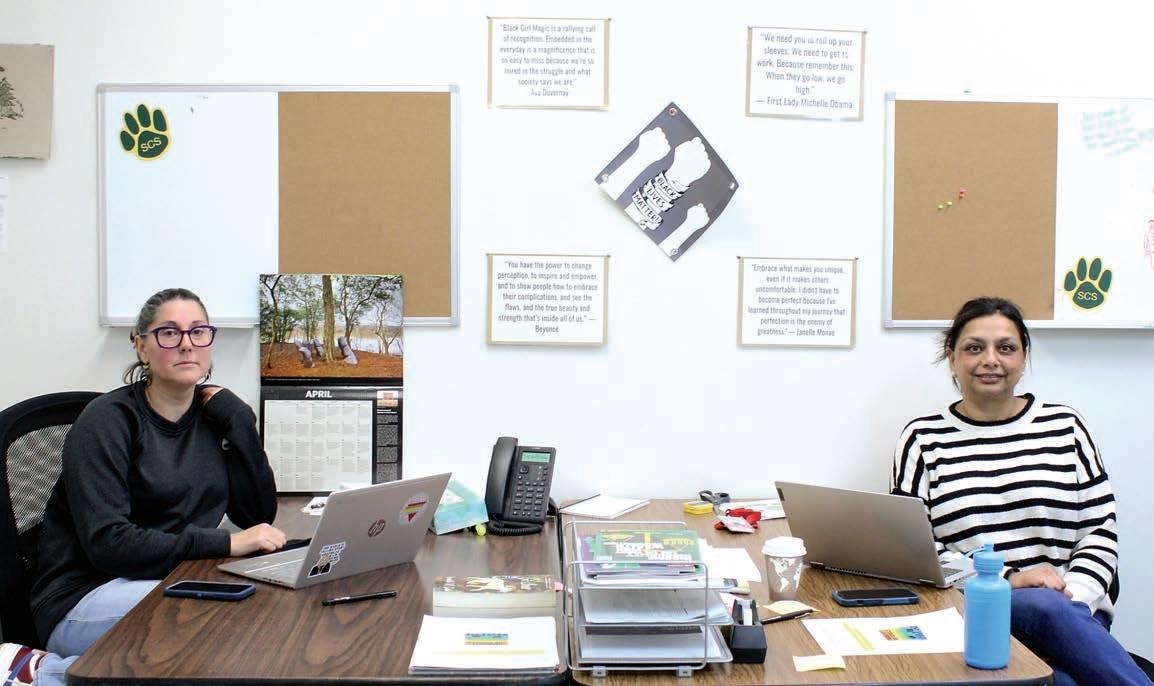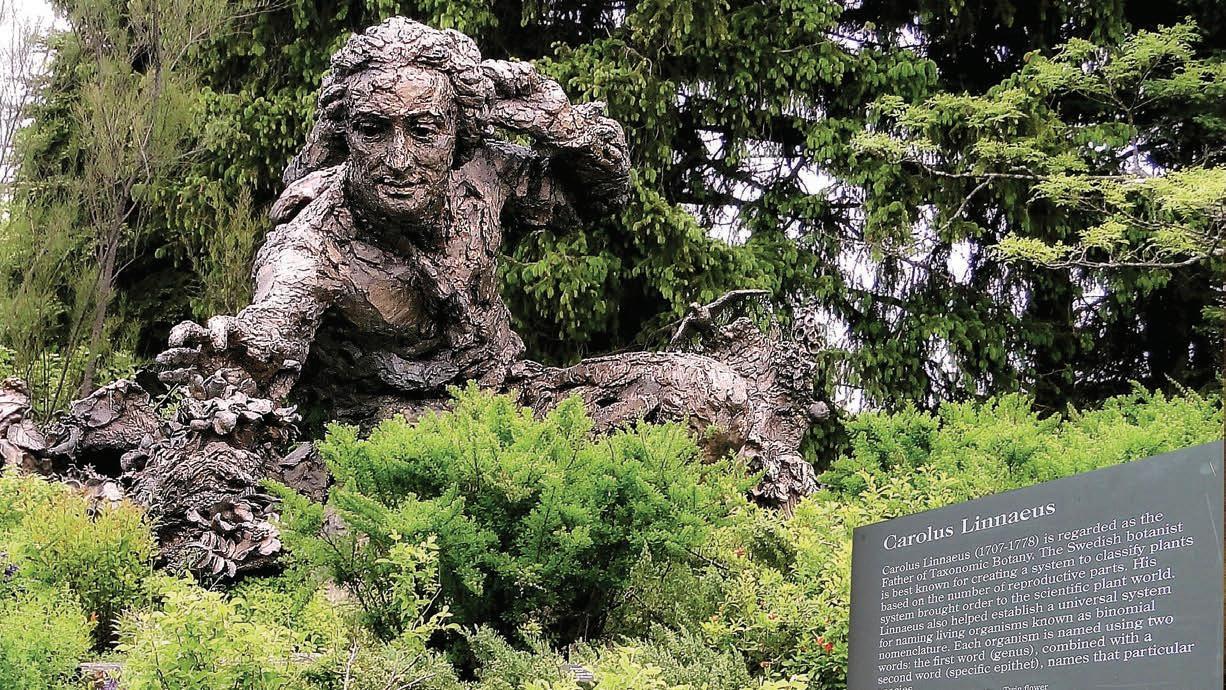




LIBERTY DARR STAFF WRITER
The Chittenden County Regional Planning Commission has released new housing targets that put Charlotte on the low scale for growth over the next 25 years.
Overall, Chittenden County has a target range of between 15,783 and 47,407 new housing units needed by 2050, according to the regional planners. As required in the 2023 HOME Act, the commission has divided the regional housing targets into individual goals for each city and town in the county.
Charlotte landed in the rural category, along with towns like Bolton, Underhill and Westford, which, combined, account for 3.8 percent of the county’s potential new growth. In Charlotte, the regional planning commission suggests growth of 11-32 percent over the next 25 years, with the annual growth somewhere between 7 and 21 percent.
Housing targets are meant as a planning tool, and there are currently no penalties for not reaching these goals, but cities and towns are expected to include the housing
See HOUSING on page 11

BRIANA BRADY STAFF WRITER
Two Champlain Valley Union High School students who were ordered to leave the country by the end of the month or face deportation will still leave, despite a judge recently blocking the order, according to school officials.

Judge Indira Talwani, a federal judge in Boston, on Monday blocked an order from the Trump Administration that sought to end special humanitarian parole protections for immigrants from Cuba, Nicaragua, Venezuela, and Haiti. The program grants temporary legal status to individuals for two years, allowing participants to work and apply for more permanent visa
status while in the United States.
“This is only a temporary reprieve and does not change the fact that the program could still be terminated upon appeal. In light of this, the CVSD students are still leaving as planned,” the school’s student
See STUDENTS on page 12

258 Market Street & Shelburne Road, S. Burlington Maple Tree Place, Williston


BRIANA BRADY STAFF WRITER
Bageshree Blasius and Christina Daudelin, staff members at Champlain Valley School District, only recently had their titles changed.
While they might be currently known as student and community engagement learning facilitators, for the last few years, the pair have been diversity equity and inclusion coaches. However, although their titles might be changing, according to the two women, the work will largely stay the same — work they say a lot of people misunderstand.
“We’re basically making sure that every student feels safe and like they belong, they feel included, they feel safe, and that their achievements are not limited by any identity” Blasius, who is also the Title IX coordinator for the district, said. “That goes for disability, it goes for race, it goes for socio-economic status. It’s every kid, and that’s what I think people don’t understand about DEI.”
students through restorative justice practices.
“Bageshree and I see every terrible thing that happens in our schools,” Daudelin said.
For example, if a child uses a slur at school, even if they don’t know what it means, Daudelin, Blasius or another coordinator is involved in resolving the issue, and helping the kids learn and heal from the situation.
“One of our things that we always say to students is it is never our job to get you in trouble, and so if you are saying these things because you have heard them, but you really don’t know what they mean, you can ask us. You can ask us the most ridiculous, inappropriate questions, because it’s our job to help you figure it out, not to punish you,” Daudelin said.
Committee. Both she and another member, Olivia Cieri, said they see how diversity and inclusion inform some of the things they’re learning in class, such as reading discussions of “The Color Purple” or “The Underground Railroad.”
“Having the space to talk about the history of America, and then also connect it to some of the things we see today, and some of the systemic issues that come from that, is important,” Cieri said.
Hem agreed, adding that talking about painful parts of history and the fiction that explores it teaches them how to have difficult discussions with each other – something she said is often missing from political conversations today.



On Monday, after having initially asked superintendents throughout the state to sign on to letters certifying compliance with President Trump’s April 3 order to remove DEI programs in order to receive federal funding in K-12 schools, Secretary of Education Zoie Saunders instead sent a letter to the federal Department of Education that offered a rebuttal.
“No federal or state law prohibits diversity, equity, or inclusion. The Request references ‘certain DEI practices’ and ‘illegal DEI,’ but neither term is defined in the Request, and no definition has been provided,” the letter read. “In Vermont, diversity, equity and inclusion practices are supportive of all students, and aim to create and sustain positive, welcoming learning environments.”
In refusing to comply, Vermont joined at least 11 other states, including neighbors New York and Massachusetts, that are defying the federal order. The National Education Association and the American Civil Liberties Union also filed a lawsuit against the order in New Hampshire, which is scheduled for a hearing after deadline on April 17.
According to Blasius and Daudelin, every day in their job is a little different. They run professional development for faculty and help shape inclusive curriculum. They also spend quite a bit of their time supporting faculty, staff, and
Blasius, as the Title IX coordinator, is also involved in mediating sexual harassment issues or cases of gender discrimination that arise.
According to the pair, at the core of what they do, however, is connecting with students. Every week at Shelburne Community School, Daudelin takes a group of boys who are struggling to connect in the classroom, and who are marginalized in some way, out to play basketball together. She said it’s helping them know that there’s an adult they can trust in the building.
“And I’m getting really, really good at schooling middle school boys in H-O-R-S-E and P-I-G,” she said.
Hailley Hem, a Champlain Valley Union High School sophomore, said when she first moved to Vermont from California in the second grade, the school put her in programming through its Culturally and Linguistically Diverse Center, which provides classes and support for students who speak another language — Hem’s parents are Chinese Cambodian, and she speaks Khmer at home.
Hem said the transition from California to Vermont was hard. She had previously been in a classroom full of Asian, Black, and Latino students. Now, there was hardly anyone else that looked like her.
“I see why they thought this program would benefit me, and it really did, since I got to be in a group with a lot of multicultural students and I’m pretty sure that would be under that category of DEI,” she said.
Now, Hem is a member of the high school’s Racial Alliance
“When we have stuff like this in our curriculum, it teaches us how to do it, and it helps encourage more open conversations in the future and hopefully helps us actually have open conversations with each other,” she said.
The district
According to superintendent Adam Bunting, the reason the school district is dropping the term “DEI” from its titles is not because it plans to change its values or programming. Instead, he said, it’s a necessary broadening of scope. Due to budget constraints this year, the district is cutting their director of student wellness. Asma Abunaib, who has been the director of diversity and inclusion, is going to take on those duties as well, and become Director of Student and Community Engagement.
Additionally, DEI, he said, has become such a politicized term that no one knows what it means anymore. He prefers engagement.
“When I talk about student engagement, I am talking about inclusion, I’m talking about diversity, we’re talking about equity. It’s all of those things. How do we make our curriculum more accessible? How do people see themselves in the curricula?” Bunting said.
Although the district may be supporting diversity, equity, and inclusion programming, according to Daudelin, there’s still room for improvement. Daudelin emphasized that the greatest diversity in the district comes from differences in socio-economic backgrounds among its students and communities, and that comes with built in inequities across the schools.
While some community schools’ PTOs can fundraise tens of thousands of dollars, she said,

BRIANA BRADY STAFF WRITER
The Hinesburg and Richmond selectboards have signed a contract for shared police chief services for the next year and put together a committee to plan out the future of policing in the two towns.
They may be cute, but young wildlife belong in the wild
Watching wildlife is enjoyable, especially when young animals appear in the spring. But it is best to keep your distance. Picking up young wildlife can do more harm than good, according to the Vermont Fish and Wildlife Department, and it is also against the law.
When people see young animals alone, they often mistakenly assume these animals are helpless or lost, in trouble or needing to be rescued. Bringing young wildlife into a human environment often results in permanent separation from their mothers and a sad ending for the animal.
Handling wildlife could also pose a threat to the people involved. Wild animals can transmit disease, and angry wildlife mothers can pose significant dangers.
Fish and Wildlife scientists encourage wildlife watchers to respect the behavior of animals in the spring and early summer, and to resist the urge to assist wildlife in ways that may be harmful. Here are some helpful tips:
Deer and moose nurse their young at different times during the day and often leave young alone for long periods of time. These animals are not lost. Their mother knows where they are and will return.
Young birds on the ground may have left their nest, but their parents will still feed them. Young animals such as fox and raccoon will often follow their mother. The mother of a wildlife youngster is usually nearby but just out of sight to a
CVU continued from page 2
others can’t, which makes a difference when it comes to what teachers might be able to buy for their classrooms or the kinds of field trips students can take.
Hinesburg Community School, she said, doesn’t have an accessible playground, meaning that paraeducators are often shoveling snow away from the tennis courts because
person happening upon it.
Wild animals can carry rabies, parasites and other diseases that are harmful to humans. Healthy-looking raccoons, foxes, skunks and bats — even babies — may also be carriers of the deadly rabies virus. Rabies cases have been on the rise in Vermont in recent years, and several baby animals tested positive last year. For your safety and the safety of local wildlife, do not handle them or try to keep them as pets.
Many wildlife species will not feed or care for their young when people are close by. Obey signs that restrict access to wildlife nesting areas, including hiking trails that may be temporarily closed.
Keep domestic pets indoors, leashed or fenced in, and vaccinate them for rabies. Dogs and cats kill many young animals each year, and pets that roam free are at higher risk for rabies.
Avoid projects that remove trees, shrubs and dead snags that contain nests during the spring and summer.
For the safety of all wildlife, taking a wild animal into captivity is illegal, even one you suspect is sick, injured or has been abandoned.
For information about what to do when you encounter an animal in the wild, and to discuss questions and concerns about rabies, please call the Vermont Rabies Hotline at 1-800-4RABIES (1-800-4722437).
The contract, as signed by the Hinesburg selectboard at its April 2 meeting, designates the town will provide police chief services to Richmond. For now, the interim chief — currently Frank Bryan — will still be considered a Hinesburg employee. The contract is set to expire at the end of next March. Separately, the current contract for general police services is set to expire at the end of this fiscal year, June 30.
While these contracts set out how the two towns will coordinate services for the next year or so, the municipalities are looking
much farther out to the future with their police planning committee, the first meeting of which was held on Monday afternoon.
The committee appointed Hinesburg selectboard member Dennis Place as its chair and Richmond selectboard member David Sander as its vice chair.
The two town managers, Richmond selectboard member Bard Hill and Hinesburg selectboard member Mike Loner are also on the committee.
In the short term, the committee has agreed that the towns will work jointly to seek out a new shared police chief, although it will be considering recruitment companies to potentially aid the candidate search and act as an outside party to the hiring process.
In the long term, the committee will discuss how the towns want to proceed with the joint policing venture, whether they move toward a single department or maintain separate forces.
The single Richmond officer, Cpl. Matt Cohen, still strongly favors a single department, largely because of the workload inherent in running two separate agencies with different protocols.
As an example, he said both he and Bryan responded to a call together in the past week. Because they technically belong to separate departments, the paperwork for the call doubled: each had to fill out separate incident reports and file through their own agencies.
Others are more hesitant about a single department.
“I just don’t think that it’s politically possible, in the next 15 months, to contemplate that,” Hill said, noting Richmond voters would have to weigh in if Richmond were to eliminate its depart-
See POLICE on page 13



it’s the only place for students with wheelchairs to go.
“You talk about getting rid of DEI, you’re not allowed to talk about DEI, you can’t be elevating anyone over another group. I think we would say no one is elevating anyone over anyone. We’re struggling to even level playing fields,” she said.











With spring cleanup underway, the Hinesburg Fire Department reminds residents that a permit is required for all open brush burning once the snow has melted. Warmer weather, dry vegetation and gusty winds can quickly turn a controlled burn into a dangerous situation — so we urge everyone to follow safety guidelines and obtain proper permits before burning.
• Permits must be obtained through Shelburne Dispatch at (802) 985-8051 prior to burning.
• Permits are available daily,
unless restricted by the fire warden due to weather or fire conditions.
• Keep fires away from buildings, vehicles and other structures.
• Only natural brush may be burned — no garbage, painted or treated wood, glued materials, tires or other prohibited items.
• Always keep a water source nearby and monitor the fire closely.
• Never leave a fire unattended. Fires found unattended will be extinguished — even if the permit holder arrives afterward.
• If a fire gets out of control, call 911 immediately.
“Our goal is to support safe and responsible burning practices that protect lives, property and the environment,” fire chief Prescott Nadeau said. “We encourage everyone to call Shelburne Dispatch before burning and follow all safety precautions.”
For more information on open burning and fire safety, contact the Hinesburg Fire Department at 802-482-2455 or visit hinesburgfd. org.
Here’s when and where the Hinesburg Fire Department reacted to calls over the past month.
March 12
10:15 a.m., Hinesburg Fire Department was dispatched to Commerce Street for a report of an unresponsive person.
1:31 p.m., mutual aid to Richmond for a technical rescue. Engine 3, Rescue 1 and Car 1 responded to provide assistance with a patient carryout.
7:07 p.m., Patricia’s Place for a report of a person with chest pain (no HFD response).
March 13
2:57 p.m., Patricia’s Place for a report of a fall.
3:07 p.m., Birchwood Drive for a medical call.
11:24 p.m., Fern Road for difficulty breathing.
March 16
10:10 a.m., Sunset Lane for a report of an ice/cold water rescue. Members donned ice rescue suits and checked a hole in the ice for a reported dog that may have gone through. No dog was found.
March 17
12:21 a.m., Fern Road for a fall.
8:34 a.m., Hemlock Road in St. George for a report of a person with breathing problems.
10:23 p.m., Patricia’s Place for a fall.
March 18
8:42 a.m., the area of Vermont Route 116 at Billings Farm Road for a report of a two-vehicle crash with injuries.
Serving the community of Charlotte & Hinesburg A publication of Vermont Community Newspaper Group LLC thecitizenvt.com
Advertising Wendy Ewing wendy@shelburnenews.com (802) 238-4980
Advertising Director Judy Kearns judy@otherpapersbvt.com (802) 734-2928
Editor Tommy Gardner tommy@stowereporter.com (802) 253-2101 x25
Staff Writers
Aaron Calvin Liberty Darr
Patrick Bilow Briana Brady
Production/Design
Stephanie Manning stephanie@shelburnenews.com Kristen Braley kristen@stowereporter.com
General Manager Katerina Werth katerina@stowereporter.com
Billing inquiries Leslie Lafountain leslie@stowereporter.com (802) 253-2101
Advertising submission deadline: Friday at 5 p.m. advertising@thecitizenvt.com classifieds@thecitizenvt.com
Editorial submission deadline: Friday at 12 p.m. news@thecitizenvt.com
Calendar submission deadline: Friday at 12 p.m. news@thecitizenvt.com
Contact: PO Box 489 Stowe, VT 05672 (802) 253-2101
2:10 p.m., Cheese Factory Road in Shelburne for a report of a brush fire. Hinesburg Engine 1 and Car 1 responded with four personnel and assisted in fire suppression and overhaul.
2:57 p.m., Vermont Route 116 at Vermont Route 2A for an outside smoke investigation.
8:25 p.m., Vermont Route 116 for a report of a person with breathing problems.
March 19
10:57 a.m., Bissonette Lane for a person with breathing problems.
2:35 p.m., Vermont Route 116 at Saint George Estates for a report of a vehicle fire. Engine 1 and Engine 3 responded with six personnel. The bulk of the

Total incidents: 31
April 8 at 9 a.m., an officer assisted someone with a disabled vehicle on Silver Street.
April 8 at 9:16 a.m., an officer responded to a two-car motor vehicle crash on Silver Street.
April 8 at 1:40 p.m., officers responded to a report of unresponsive individual on Commerce Street. Ryan Orvis, 46, of Burlington, was responsive upon police arrival and cited for driving with a crimi-
nally suspended license. April 8 at 2:45 p.m., officers responded to Commerce Street and removed an individual from Aubuchon at the request of the owner.
April 8 at 3:18 p.m., police conducted a welfare check on Buck Hill Road East.
April 8 at 5:42 p.m., an officer assisted Bristol police with attempting to serve a citation.
on page 9





Guest Perspective
Josh Moore & Justin Silverman
On March 25, masked federal immigration authorities detained Tufts University Ph.D. student Rümeysa Öztürk for engaging in what Trump administration officials said were “activities in support of Hamas, a foreign terrorist organization that relishes the killing of Americans.”
Öztürk’s attorney, however, has said she is not aware of any criminal charges against the student and when asked to detail the specific activities warranting the student’s visa being revoked, U.S. Secretary of State Marco
Rubio would not do so. Meanwhile, a Tufts spokesperson has said Öztürk is a student “in good standing.”
The only publicly known activity one might tie to Öztürk’s detention is an op-ed she penned for The Tufts Daily more than a year ago — a column critical of the Israel-Gaza war but one that university officials said did not violate campus policies on protests and expression.
If this is the basis for her detention, Öztürk’s current incarceration is a blatant disregard for the principles of free speech and a free press. It’s also a warning to student newsrooms that mere criticism of government can be punished despite protections for
such speech entrenched in our country’s history and enshrined in our constitution.
The Student Press Law Center and the New England First Amendment Coalition — joined by other journalism advocates such as Freedom of the Press Foundation and PEN America — are asking the Tufts administration to publicly demand that ICE release Öztürk; clarify that her detention undermines the university’s values; and reaffirm protections for international students’ free speech rights.
While Öztürk’s op-ed is critical of the Israel-Gaza war, many Americans across the political spectrum, regardless of where they were born, share
Guest Perspective
Sarah Robinson
At the Vermont Network Against Domestic and Sexual Violence, we support survivors of domestic and sexual violence, amplify their voices and build safer communities. We collectively represent 15 independent nonprofits that provide direct services to survivors and prevention programming in their communities.
S.27, a proposal to eliminate up to $100 million in medical debt for low-income Vermonters and exclude medical debt from credit reports, supports this work. Brought forward by Sen. Ginny Lyons, D-Williston, and Treasurer Mike Pieciak, the bill is a critical step toward helping survivors achieve economic security, better health outcomes, and a safer future.
Economic security is a significant barrier to safety and healing for survivors. As healthcare costs rise in Vermont, survivors are more vulnerable to accruing medical debt as a direct result of abuse.
The National Institutes of Health estimates that the lifetime financial loss from intimate partner violence exceeds $100,000 per female victim, with healthcare expenses accounting for most of that cost. Research shows that survivors have higher health care costs, even years after escaping abuse.
An emergency room visit, or mental health care, can leave people burdened by debt through no fault of their own. That debt can damage their credit, making it harder to secure housing, find employment, and escape an abusive partner. Medical debt can also lead to worse health outcomes. Studies show that tens of thousands of Vermonters delay treatment out of fear of medical debt.
This can result in more serious health issues, higher future medical costs, and time away from
work. When someone is unable to pay their medical bills, everything else —including their safety — becomes less affordable.
Nothing should hold survivors back from moving forward with their lives. On behalf of the Vermont Network, we encourage the legislature to support S.27, an investment in Vermonters’ safety, health and prosperity.
Sarah Robinson is co-executive director of the Vermont Network Against Domestic and Sexual Violence.
similar concerns. Öztürk and her co-authors say nothing in the op-ed remotely supportive of Hamas or terrorism. Instead, they focus on their university’s actions and call upon the administration to engage with and listen to its students. This is precisely the type of speech that should be welcomed and protected at universities.
The opinion pages of student newspapers have a long tradition of open dialogue and debate on the important issues of our time.
to counteract by weaponizing visa status against criticism. When students face detention or deportation for lawful expression, it sends a message to all that the price of dissent is exile.
that value free speech rights don’t seek out opportunities to disregard them.
Students must have the room to lawfully express themselves free from government interference. Rounding up a student for an article that she published is a clear attempt to silence speech and interfere with Öztürk’s First Amendment rights.
This alarming incident is the latest example of the Trump administration unlawfully targeting student speech. Mahmoud Khalil was arrested on March 8 for his peaceful protest and social media posts while attending Columbia University. Khalil’s case marked the beginning of a dangerous pattern of using immigration enforcement to punish dissent, a tactic straight out of the playbook of authoritarian regimes.
Our country must not follow the lead of authoritarian governments it has worked for decades

In response to Öztürk’s arrest and other detentions, international students are now removing social media posts and refraining from political speech altogether. This is a violation of our First Amendment right to hear from and associate with noncitizen students, according to a lawsuit recently filed by several academic associations against federal officials.
The Trump administration’s ideological-deportation policy, they argue, makes it more difficult for them to learn from these students. Student speech is now chilled due to the “all-too-real possibility” that noncitizens “will be arrested, imprisoned, and deported for exercising rights that the Constitution guarantees.”
The First Amendment is an asset, not an inconvenience. Citizens and noncitizens alike are entitled to free speech. Institutions that value free speech rights don’t seek out opportunities to disregard them. Student visas may be the lowest hanging fruit for now, but those who revoke
See DETENTION on page 13
From the House
It’s a weird time in the Statehouse. We’re making all these laws and working on a budget and, honestly, we don’t know how much money we’re going to have from the federal government with each passing day.
But we’re carrying on as if everything is going to be all right, because of course, it is. We’ll figure it out.

I have a few things to address this week: the Charlotte town charter, the education bill, how are we going to prevent ourselves from losing democracy, and an event coming up. In no particular order of importance, of course.
First, the charter. We passed the proposed charter on Town Meeting Day. It essentially asks the Legislature to allow Charlotte to exempt ourselves from a portion of a law that was passed last year. The HOMES act was a large bill that addressed different ways in which creating housing could be made easier. One of those changes was allowing the governing bodies of municipalities — in our case, the selectboard — to make changes to land use regulations without a town-wide vote.
In years past, we had these big documents that included a pile of changes, everything from food truck policies to changing a comma. We then voted on all the changes as a town via Australian ballot. This change in the HOMES act removes the town-wide vote requirement.
Except in Charlotte, we voted that we don’t want the selectboard to make those changes; we all want to make the changes. Or at least a majority of us do.
The charter process (I know I’ve really gotten overly enthusiastic about Dillon’s Rule here before so I won’t do it again, but believe me, the passion is still here) means that the Legislature must approve any charters or charter changes. My committee, as it happens, approves all the charter bills that come through the House.
I’m presenting the town charter
bill introduction this Friday the 18th at 1 p.m. in my committee, and then we’ll take testimony in the coming weeks. If you’re interested in weighing in on the record, be in touch and I’ll get you on the agenda.
We passed H.454, the big education bill, out of the house last week. Sometimes we pass bills and we know nothing, or little, is going to change during its time in the Senate. Like, maybe the bill goes to summer camp and grows an inch but is basically the same when it comes back.
This bill, which took a ton of work and hours of floor debate, will come back from summer camp with a whittling hobby, a tattoo done with a ballpoint pen by its bunkmate, a new hair color and it will reject its childhood nickname. It’ll still be the same camper, just really different.
The goal of this bill is to do just a couple of little things like completely rehaul our education system across the state and completely rehaul the way we pay for public education. So, as you can imagine, it’s not a quick fix, nor should it be.
At the moment, we don’t know what it will look like, but as always, whenever anyone asks for my opinion, I tell them my most important priority is the kids.
Americans — people with green cards, people who are legally allowed to be here — are being arrested in our state, or being arrested and brought to our state, because the president’s administration doesn’t like their politics. This should scare the bejesus out of every single one of us.
If you’re not a person who gets involved, or tries to stay out of politics, or would rather spend your spare time watching television, I urge you to — when you finish the latest season of “The White Lotus,” of course — do something.

It can be little. Email me or your senators or Becca and Bernie and Peter. Call the governor and ask him to stop putting his party over our people.
Or it can be bigger: go to a protest, write an op-ed for the paper, hold an informal gathering in your yard around the firepit to talk with your neighbors and friends about action you can take. This is serious. No matter if you’ve lived here for two weeks or two generations, you’re a Vermonter. We do stuff.
Finally, Attorney General Charity Clark is joining me at the Charlotte Town Hall on April 29 at 6:30 p.m. She’s going to discuss her work to protect the rule of law and Vermont’s sovereignty. As of writing this, she’s already filed nine lawsuits against the Trump administration, but there are surely more to come every day. It’s going to be interesting and entertaining and hopeful, and I’d love to see you all there.
You can find me at cevans@ leg.state.vt.us or 917-887-8231. Our state motto is “Freedom and Unity,” and I really think now is the time for us, no matter what our disagreements are, to see how much we all believe in both of those things.
Chea Waters Evans, a Democrat, represents Charlotte and Hinesburg in the Chittenden-5 House district.
To the Editor: Rep. Phil Pouech is mine because I live in Hinesburg, a small town with a reasonable budget and great people. But what I have learned is that very few residents actually speak out on important issues unless surveyed, and, as always, it’s great to hear from Mr. Pouech. I think many of my fellow citizens would totally agree that our elected political leaders should speak out on issues that are important to them and us. But sometimes I respect leaders who are not quick to respond and who consider their impact on the wider issue being discussed, and
I have come to respect our governor for his concern and leadership — especially on important issues that directly impact my wallet.
But now that you bring it up, couldn’t we also ask, where has the Legislature been over the past several years as important issues have dominated our economy and social ecosystems? It’s been no secret what problems have plagued us: education spending, property taxes, health care costs and availability, homelessness, rational climate policy, zoning, forestry, etc.
It seems to me and many others that our legislators love to
ANDREA KNEPPER
UVM EXTENSION
Rudbeckia hirta. Solanum lycopersicum. Acer saccharum.
Have you ever seen these names on plant tags or seed packets and wondered where they came from? We can thank Carl Linnaeus for taxonomy, the study of categorizing and naming organisms, and binomial nomenclature, the precise, two-termed naming system we use today.
Carl Linnaeus was a Swedish professor, scientist and doctor who was born in 1707. From a young age, Linnaeus was fascinated by the plants growing in his father’s garden.
At the time, plants were scientifically named in Latin by describing their features. These names were often long and described multiple unique plant traits. Linnaeus was determined to learn as many as he could, sometimes neglecting his formal studies.
Linnaeus began studying medicine when he was 19 years old. Notable naturalists and botanists of the time noticed his interest and ability. They invited him to become a botany teaching assistant at Uppsala University. During his 20s, Linnaeus continued to study, travel and collect specimens.
While traveling and collecting detailed information on the natural world, Linnaeus completed his medical degree, practiced medicine and became a professor of botany.
Linnaeus proposed a system to classify and describe these specimens by sorting and relating them to other known organisms. He first described this system in his 1735 work, Systema Naturae.
According to this initial system, plants and animals were sorted into a kingdom, class, order, genus and species. These categories are ranked from most general to most specific. This is why we use the genus and species names to precisely identify organisms.
Over time, scientific discoveries have expanded this system to include the ranks of kingdom, phylum, class, order, family, genus and species. Discoveries have required the addition of kingdoms to include non-plant and animal living things, like bacteria, fungi and single-celled organisms.
We call this system of giving scientific names binomial nomenclature. “Binomial” means two names and “nomenclature” means naming system.
Scientists italicize the two terms in a scientific name. The first is the genus and is always capitalized. The second is the species.
Plants that are a specific variety have an additional name after this. For example, Rudbeckia hirta var — hirta is the black-eyed Susan

native to the eastern United States while Rudbeckia hirta var. floridana is a variety native to Florida. Sometimes, the variety name will appear in quotations instead.
Home gardeners can use scientific names to confidently obtain the exact plants they need.
One year when I was selecting
seeds for my garden, I was excited to see huckleberry seeds. Thinking about my travels on the west coast and experiences with huckleberry jam and pie, I ordered the seeds. I planted the seeds and was truly disappointed by my results. I had to add a lot of sugar to make the jam palatable, and the flavor
was quite different. When I looked more closely at the seed packet, I noticed that the botanical, or scientific, name was actually Solanum scabrum, not the Vaccinium ovatum I was hoping for.
Next time you spot an interesting plant, take a closer look at its scientific name. This detail can
ensure you get exactly what you expect. Thanks to Carl Linnaeus, we have a universal language to connect scientists and gardeners around the world.
Andrea Knepper is a UVM Extension Master Gardener from Bolton.































Hinesburg church keeps tradition with plant sale
A 50-plus year tradition at the United Church of Hinesburg continues with the 2025 Plant Sale. The online sale of locally grown perennials and beautifully packaged homemade biscotti runs April 12-27, with orders ready for pick up on Saturday, May 17. The church’s in-person sale of annuals, including hanging plants, and home-baked pies will be held Saturday, May 10, just in time for Mother’s Day.
Access the online store by clicking the Plant Sale button on the home page of the church website, ucofh.org. Place your order and pay with a credit or debit card. Shop early to ensure the best selection.
Contact the United Church of Hinesburg with any questions at (802) 482-3352 or unitedchurch@ gmavt.net.
‘Muttville’ comedy show features rescued dogs
Johnny Peers and his personality-plus canines are coming to Middlebury’s Town Hall Theater, 76 Merchants Row, Middlebury, Sunday, April 27 at 4 p.m. Peers will lead more than a dozen dogs through challenging and hilarious tricks as he plays the straight man role.
A Ringling Brothers Clown College graduate, Peers has been working with dogs since he got his first puppy, Freckles, a beagle mix, from the Humane Society. Since

their 1980 debut, the Muttville Comix have appeared on David Letterman, Primetime Live and Circus of the Stars, and at Disneyland, Busch Gardens, the Big















482-5777
continued from page 4
fire from a utility trailer was out upon HFD arrival. HFD performed fire suppression and overhaul.
March 20
11:58 a.m., Farmall Drive for a medical emergency.
March 21
11:52 p.m., Vermont Route 116 at Clinton Street for a report of a single-car accident.
March 22
3:14 a.m., Birch Road in the town of St. George for a seizure.
8:34 a.m., Bissonette Lane for a medical emergency (no HFD response).
March 23
1:35 p.m., Hemlock Road in St. George for a medical emergency.
March 24
4:22 p.m., Leavensworth Road for a medical emergency.
continued from page 4
April 8 at 9:37 p.m., officers responded to a report of threatening behavior on Route 116. A person was brought to the University of Vermont Medical Center on a mental health warrant.
April 9 at 3:25 p.m., police investigated a report of erratic operation of a vehicle on CVU Road.
April 9 at 8:42 p.m., an officer responded to a report of a dispute between residents on Leavensworth Road.
April 11 at 2:00 p.m., police investigated illegal trash dumping on Sherman Hollow.
April 14 at 7:00 a.m., an officer investigated a report of suspicious activity on Haystack Road.
April 14 at 7:30 a.m., police investigated theft of property from a motor vehicle on Kelley’s Field Road.
April 14 at 7:42 a.m., police investigated a report of suspicious activity on Kelley’s Field Road.
April 14 at 9:18 a.m., officers responded to a domestic dispute on Richmond Road.
April 14 at 9:40 a.m., police investigated a report of threats made over the internet on Kelley’s Field Road.
April 14 at 11:57 a.m., police investigated theft of property from a motor vehicle on Buck Hill West.
April 14 at 2:04 p.m., a loose dog was turned into the police and the owner was later located.
April 14 at 9:19 p.m., police assisted a resident on Route 116 with a lockout.
Note: Charges filed by police are subject to review by the Chittenden County State’s Attorney office and can be amended or dropped.
5:00 p.m., Friendship Lane for a report of a person choking.
March 28
8:35 a.m., Lewis Creek Road for a medical emergency.
9:36 a.m., Ledgewood Lane for a public assist.
10:39 p.m., Patricia’s Place for a fall (no HFD response).
March 29
12:09 a.m., Richmond Road for a childbirth (no HFD response).
8:57 a.m., Pond Road for a medical emergency (no HFD response).
March 30
8:43 p.m., Burritt Road for a report of a power pole on fire.
March 31
8:52 a.m., Patricia’s Place for a fall.
10:02 a.m., Jourdan Street for difficulty breathing.
7:38 p.m., Birchwood Drive for a medical emergency.
April 1
1:48 a.m., Vermont Route 116 for a medical emergency.
4:56 a.m., Jourdan Street for difficulty breathing.
8:55 a.m., Hollow Road for an unresponsive person.
April 2
2:58 p.m., Vermont Route 116 for an outside smoke investigation.
April 4
1:02 p.m., Jourdan Street for difficulty breathing.
April 5
1:57 p.m., Kelley’s Field Road for a fall (no HFD response).
April 7
4:52 p.m., Spear Street in Charlotte for a brush fire. Engine 1 responded with two personnel and assisted in fire suppression.
6:03 p.m., Eastry Court in Charlotte for a chimney fire. Engine 1 responded with two person-



nel and assisted with the investigation.
6:19 p.m., Vermont Route 116 for a report of an unresponsive person.
7:32 p.m., Hemlock Road in St. George for a report of someone bleeding.
8:55 p.m., Wile Street for a medical emergency (no HFD response).
April 8
8:36 a.m., Vermont Route 2A for a report of a person with difficulty breathing.
9:42 a.m., Kelley’s Field Road for a report of chest pain.
1:41 p.m., Commerce Street for






a report of an unresponsive person.
10:14 p.m., Vermont Route 116 for a medical emergency.
April 9
4:26 a.m., Hayden Hill Road West for a medical emergency (no HFD response).
11:38 a.m., Hollow Road for a medical emergency.
1:46 p.m., Vermont Route 116 for a report of a fire alarm activation.
April 10
2:33 p.m., Vermont Route 116 for a person with difficulty breathing.










Emily Haynes
When the winter snow melts and the spring rain begins, vernal pools appear on the landscape. These ephemeral wetlands form in depressions in forests or ridge lines and offer essential breeding habitat to amphibians and invertebrates, including wood frogs, spotted salamanders, and fairy shrimp. Because vernal pools dry up in high summer and are disconnected from other waterways, fish cannot survive in them – making them uniquely attractive to many amphibian and invertebrate species.
“It’s the lack of fish that allows them to treat it like a nursery with essentially no serious new aquatic predators,” said Kevin Tolan, staff biologist at the Vermont Center for Ecostudies and coordinator of the center’s vernal pool monitoring project.


their brief lifespan includes dry years when the vernal pool doesn’t refill.
While invertebrates and amphibians that use vernal pools do not have to contend with fish, they do face the threat of many other predators. Raccoons, minks, and skunks will happily snack on egg masses. Tolan has even seen pet dogs chowing down on amphibian eggs.
“Anything will eat a little baby salamander,” he said.
Trail cameras have captured these owls wading through pools and trapping amphibians under their talons.
Not all species that use vernal pools require them to survive, but some do. Creatures who depend on vernal pools are known as obligate species. These include spotted salamanders, whose charcoal-colored bodies are decorated head-to-tail with lemon yellow spots.
They spend nearly the entire year underground, tunneling beneath the frost line to survive the cold. On the first warm, wet nights of spring they emerge to breed in the vernal pools in which they were born.
A female spotted salamander can lay hundreds of eggs in one night. She lays her eggs in ovular masses that cling to sticks and grasses near the pool’s surface. These masses can look like strange, forgotten crafting projects: jumbles of googly-eyes chilled in jelly.
Spotted salamanders can grow up to 10 inches and live as long as 20 years. Wood frogs, another obligate species, typically live for only five years and will lay thousands of eggs in one sitting. This breeding strategy ensures species survival even if
Predation at vernal pools is, in part, due to the time of year when they occur on the landscape. In early spring, the ground is still thawing and there are few other sources of food. The pools offer a proteinpacked buffet to species that are awakening from winter dormancy or returning from seasonal migration, including black bears, some raptors and wading birds and several species of turtle.
“Even though they’re physically small compared to many other wetland types, because there’s so much activity in them at a time when the rest of the land is sparse, they can play an important role in early spring,” said Brett Amy Thelan, science director at the Harris Center for Conservation Education.
Solitary-sandpipers have been spotted feeding at vernal pools in the spring on their long migrations from Central America, the Caribbean, and South America. They hunt on their own, searching for crustaceans, insects, and amphibians. Broad-winged hawks are also known to hunt at vernal pools during their migration journeys from Central and South America. These crowsized raptors love eating frogs, toads, and other amphibians, and will also eat crustaceans and insects. Great blue herons also feed at vernal pools in early spring.
Barred owls are one of the most prolific predators at vernal pools. Although these predators typically hunt from perch-
See OUTSIDE STORY on page 11























continued from page 1
targets in their municipal plans and identify actions they’ll take toward meeting them. Charlotte will undergo a rewrite of its town plan next year.
While cities and towns typically don’t directly create housing, they can create conditions that make it easier, like adjusting zoning laws, expanding water and wastewater infrastructure and working with the private sector. The Chittenden County Regional Planning Commission encourages cities and towns to accommodate most of the housing in downtown centers, village centers, planned growth areas and village areas.
Those areas are shown and defined on the draft Chittenden County Future Land Use map, outlined in the newly passed Act 181, legislation that takes initial steps to reform and modernize Act 250, Vermont’s half-century-old land use law.
The new law recognizes that much of Vermont has shifted since 1970, when Act 250 was passed. As the state grapples with an acute housing shortage and attracting or retaining young families, Act 181 looks to update how the state handles planning altogether.
The law is meant to encourage new housing by reducing permitting requirements and directing state funds to areas that are planned for growth by drafting a future land use map that will recommend where to make it easier to build housing and businesses, and where to prioritize other land uses like recreation and agriculture.
But as the state buzzes with
continued from page 10
es high up in the trees, they’re not averse to getting their feet wet.
“I’ve seen them hunting by going down into the water and shuffling through and picking salamanders in the shallows,” Thelan said.
Trail cameras have captured these owls wading through pools and trapping amphibians under their talons. They’ll nibble on them with their sharp beaks and then fly off to finish their meal undisturbed.
Thelan leads salamander crossing brigades for the center, which involves spending many rainy nights in early spring along roadsides throughout New Hampshire’s Monadnock region, helping frogs and salamanders safely cross busy roads and monitoring the migrating populations.
“It is not uncommon to see a
talk of housing and developments, Charlotters have been having their own conversations about growth in town. A new ad hoc group of development review board, planning commission and conservation commission members is looking to start its own mapping project.
“I would say, two weeks in, we are cautiously optimistic about it and that they were thoughtfully developed,” Bob Bloch, co-chair of the town planning commission, said about the housing targets.
The group, made up of three members from those boards and commissions, is crafting its own map of every property in town to determine realistically how many of those properties could be subdivided to create more housing.
Part of the work aims to help residents understand what is happening with the town’s own Village Planning Project, a two-year comprehensive deep dive into the future of the town’s East and West villages. The project was launched to minimize sprawl while encouraging more compact, walkable areas in town.
“I’m sitting there on the planning commission and I’m sort of leaping ahead to say, ‘How do you explain this to people?’” Bloch said. “Government views it like, ‘Well, we warned it. We had a hearing. We did the outreach.’ And we realized you really have to take the time to help people learn and understand more about the issue.”
The group is mapping, by hand, all of Charlotte’s nearly 26 square miles of land. It has
been relatively easy for the group since development review board chair Charlie Russell who is an unofficial member of the ad hoc group knows a thing or two about mapping.
“Charlie laid out the maps in the town hall and he did some preliminary work. He loves his stuff,” Bloch said. “So, we’ll look at every lot and we know where the houses are and then we’ll sort of go quadrant by quadrant and count.”
Bloch remembers when he joined the planning commission, he questioned whether the town had devised its own buildout map, and at that point, it had not. But the group hopes that this could at least inform where subdivisions could happen based on the town’s current and potential future zoning regulations.
Claudia Mucklow, chair of the conservation commission, is also a member of the group, keeping an eye toward wetlands, steep slopes and conserved areas that make any sort of development or growth impossible.
Her biggest concern is ensuring those areas remain untouched. She said it’s unlikely the majority of these properties will get built out, since most of them are on private property.
The group has only met twice, and it remains to be seen how much this map will help inform the planning process, but its members hope to help residents get a clearer picture of their town.
“It’s certainly not going to be private, and we’ll figure out how to share it,” Bloch said. “But we just said let’s do this. Let’s stop yakking about it.”




barred owl hunting by the side of the road on those nights – they’re keyed in,” she said.
Now is a great time to search your local forests for vernal pools because wood frogs are becoming active again. Listen for the sound of their throaty, squabbling chorus on a warm day and it will likely lead you to a vernal pool. You may even catch a predator stopping by for a tasty meal.
Emily Haynes is a writer currently living in Washington, D.C. An avid birder and hiker, she loves exploring the forests of the Northeast. Illustration by Adelaide Murphy Tyrol. The Outside Story is assigned and edited by Northern Woodlands magazine and sponsored by the Wellborn Ecology Fund of New Hampshire Charitable Foundation: nhcf.org.









continued from page 1
and community engagement facilitator, Christina Daudelin, said in an email Tuesday.










According to an earlier email sent to Champlain Valley School District staff and families last week, under the initial order from the U.S. Department of Homeland Security, the teens, who are originally from Nicaragua, had been told they had until the end of April to vacate the country or face deportation.
As with other immigrants across the country, this ended the term of their stay before the two years of the program.
Both students are seniors, and per the requirements of the humanitarian parole protection, were sponsored to move to the United States by a family member in the area. According to Daudelin, the district plans on helping the teens earn their diplomas before the end of the month and holding a private graduation ceremony for them this week.
lies, which was signed by superintendent Adam Bunting and union president Emily McLean “on behalf of many, many adults at CVSD,” argued that, in ending the program early and forcing their expulsion from the country, the Trump administration is ignoring regular immigration processes.
“These students are not political operatives. They are not criminals. They are not threats. They are young people who have found safety and meaning in our community.
“We need our students to know that they are our community.”
— Christina Daudelin
Daudelin was there the day one of the students came in to register at the school. She also had one of them in a two-week course focused on social justice in the United States. In the year and a half they’ve been here, she’s seen them grow.
They’ve made friends, joined clubs, and played in the snow here for the first time.
They’ve done what all teenagers do: tried to figure out who they are, where they belong, what they care about,” the email read.
Champlain Valley is the largest school district in the state, but the sending towns are suburban and rural. The communities range in population from less than 800 in St. George to just over 10,000 in Williston.
email was included in the message from the district, was inundated with messages from community members – most expressing their horror at the situation and asking what they could do.
Whether or not the order is overturned or upheld through an appeal, Daudelin hopes the community will act.
“We want people to contact their representatives and their senators and things like that, and make sure that our voices are being heard. But the most important thing right now for us is that we need our community to know this is happening. We need our students to know that they are our community,” she said.
According to Bunting, the district has also heard from Sen. Bernie Sanders’ office as well as all their local representatives. Like Daudelin, he said he has also been receiving an influx of messages from concerned residents.
“I see our community saying ‘Oh, this is about our kids.’ They’re saying our kids, whether they’re our own students or they’re students from abroad,” he said.
Community members are planning for a series of sign brigades near the high school to protest federal policies that affect students, including immigration policies.
“This isn’t just happening to college students in big cities,” the email continued. “It’s happening to teenagers who live and work in our community. It’s happening to young people who are doing everything we say we want from immigrants: integrating, contributing, showing up, learning, and caring.”
“I think the general feeling for myself when I found out was ‘this is happening, there’s nothing we can do,’ and just sheer rage,” she said.






















The email to staff and fami-
Sitting in her office last Thursday morning, Daudelin, whose
“Area residents concerned about the threats to international students in Hinesburg will be making our opinions known and heard this week,” the announcement read. “All, including students and the CVU community, are welcome to join us!”



• View a complete online copy of the print edition
• Read the latest news
• Find out about sales and events
• Stay up to date on local happenings VTCNG.com/TheCitizenVT/digital_edition
Sign up for our Friday EMAIL NEWSLETTER
Headlines and news sent directly to your inbox every Friday at 10 a.m.
Sign in and add your weekly newsletter: VTCNG.com/users/admin/mailinglist

LETTERS continued from page 6
study issues ad infinitum. These studies cost money and time, but I wonder if they take the time to read the reports that have been generated over the years. Doesn’t it actually seem that many of the answers we are looking for now have been detailed many times already in these long and highly detailed, lovely reports from studies? But when legislators would prefer not to act, they generate another study.
I love Vermont and have lived here all my life, and I joined the Army to fight for it. I desperately want Vermont to succeed and for Vermonters to have access to any
and all services that would allow them to live a long and fruitful life. Isn’t that the ultimate responsibility of any political leader?
One thing I have discovered from my time in the service is you can’t identify who will become a great leader, and you can’t teach leadership, but great leaders are needed to make up for the ones that aren’t. What I do believe is that great leadership comes from the heart, empowering a force of action that even the mind wouldn’t advise. Great leaders rise to the occasion.
I think what many Vermonters are looking for is action by the Legislature that allows the governor to move forward on fixing our problems. Are there any leaders in the Legislature who will put politics aside for the good of the people? We need your help, not your questions. Stakeholders have had their way in the past, necessitating Vermonters to spend far more than what was needed on education. Now let’s work together to fix it.
John Clifford Hinesburg
continued from page 3
ment and contract with Hinesburg for all aspects of policing.
However, whether that single department involves Richmond contracting with Hinesburg remains up for debate. In response to Hill, Hinesburg town manager Todd Odit suggested that the committee consider more creative ways of combining long term.
“Recently, I thought about a hybrid model, where both towns are contributing resources that tie them together, but make them
continued from page 5
visas of op-ed writers are sure to seize upon any legal theory that might permit them to punish others with whom they disagree.
Academic freedom cannot thrive if students face deportation for participating in campus discourse and there is nothing more central to the American tradition of free speech on campus than student commentary on U.S. foreign policy.
Journalism is not a crime. Criticism is not a crime. They are instead essential parts of a healthy democracy, one that
feel like they have equal footing beyond just a contract for service,” Odit said.
As a hypothetical suggestion, Odit posed a model where Richmond might be the official hiring town, but the force is referred to as the Richmond-Hinesburg Police and its main base remain at the Hinesburg facilities.
The committee has a goal of creating a vision for its shared police services by next budget season.
IZZY WAGNER VTDIGGER
Mud season has returned, accompanied by state officials’ annual reminder to stay off soggy trails until they dry out.
“We encourage the public to get outside this spring, but to avoid closed and muddy trails,” Becca Washburn, the director of lands, administration and recreation for the Department of Forests, Parks and Recreation, said in a March 31 press release. “Enjoy the spring sunshine on open trails, like paved and gravel bike paths, and save the summit destinations for summer.”
we are seeing quickly erode. This effort to chill dissent may start with students, but it likely will not end there. If the federal government can punish a student for an op-ed in a campus newspaper, what will prevent it from doing so with professional journalists and others with whom it disagrees?
continued from page 2
Josh Moore is the assistant director at the Student Press Law Center. Justin Silverman is executive director of the New England First Amendment Coalition.
Mud season generally occurs during a six-week period between snowmelt and Memorial Day, according to the department. Due to their increased susceptibility to damage during this period, trail closures, especially in high-elevation areas, can last until late May.
Varying conditions throughout the state mean that the severity and duration of mud season are difficult to predict, according to Claire Polfus, recreation program manager at Vermont’s Agency of Natural Resources.
Marvin Boyd, a meteorologist
at the National Weather Service, said the amount of rainfall in Vermont this year is slightly higher than the climatological average over the past 30 years, which could suggest a muddier year.
However, more rain does not necessarily correlate to a worse mud season, especially in terms of road conditions. Conditions deteriorate on wetter roads, but drainage and infrastructure could also impact how long they stay muddy for, he said.
“There’s no measurement for muddiness,” meaning mud reports are often subjective, he said.
While popular high-elevation areas such as Mount Mansfield typically remain closed until the start of the summer hiking season, The Green Mountain Club has a list of alternatives to popular peaks that close during mud season and seasonal hiking recommendations.
Hiking muddy trails can cause long-term damage since excess foot traffic creates soil compaction — or denser soil that cannot easily absorb water. This leads to increased flood risk, and makes it difficult for vegetation to grow.
The week-long bait drop is a cooperative effort between Vermont and the U.S. Department of Agriculture Wildlife Services to stop the spread of the potentially fatal disease.
Rabies is a deadly viral disease of the brain that infects mammals. It is most often seen in raccoons, skunks, foxes, and bats, but unvaccinated pets and livestock can also get rabies.The virus is spread through the bite of an infected animal or contact with its


Additionally, hikers can widen the trails by walking along their edges to avoid mud puddles. Doing this can trample vegetation, causing more environmental damage, according to the Green Mountain Club.
Less disruption to the trails during mud season “makes life a lot easier” for trail crews during the remainder of the year, according to Keegan Tierney, the club’s director of field programs.
Trail maintenance is primarily a volunteer-driven operation, Tierney said, and the responsibility to repair hiker-induced damage often falls upon trail crews and volunteer groups.
“Our crews are working every summer to fix up our trails,” Polfus said. “Every time we add more to their to-do list, it’s taking away from their overall progress.”
saliva. If left untreated, rabies is almost always fatal in humans and animals. However, treatment with the rabies vaccine is nearly 100 percent effective when given soon after a person is bitten by a rabid animal.
lthough the recommendation to wait out the mud can be frustrating, Polfus said staying off delicate trails is a way individuals can help protect the environment.
“We all have spring fever and want to get out to our favorite place, but Vermonters care, and the best way to care is to just wait until May, or late May,” she said.
So far this year, 23 animals in Vermont have tested positive for rabies, and 14 of those have been raccoons.
According to wildlife officials, rabid animals often show a change in their normal behavior, but you cannot tell whether an animal has rabies simply by looking at it. People should not touch or pick up wild animals or strays – even baby animals.


SHELBURNE continued
Shelburne display lead a cemetery dors round from coffee creemees. from





















continued from page 8
The performance stars mostly dogs rescued from shelters or pounds, like Daphne, the world’s only skateboarding basset hound; Squeaky, the ladder-climbing fox terrier; Mr. Pepe, who only responds to commands in Spanish; and Sir Winston, the pointer mix who only answers to “Sir.”
There will be photo ops and a meet and greet with the star canines after the show. Tickets: $20 for adults and $10 for children 12 and under and may be purchased at townhalltheater.org.
It’s the time of year when change comes apace, and Social Band will honor this springtime with songs that express the nuances of transformation and the cycles of life — whether it be lessons learned from growing plants or molting insects. Social Band will present its signature mix of choral music, from Josquin de Prez to new compositions, along with a refreshing dose of poetry, robust harmony, and singing camaraderie.
For Richmond, South Burlington and Charlotte concerts, suggested donation is $20.
Dates:
• Saturday, April 26, at 7:30 p.m., Richmond Free Library, 201 Bridge St., Richmond Sunday, April 27at 3 p.m., Faith United Methodist Church, 899 Dorset St., South Burlington
• Saturday, May 3, at 7:30 p.m., Shelburne Town Hall, 5420 Shelburne Rd., Shelburne. This performance is free and open to the public.
• Sunday, May 4, at 3 p.m., Charlotte Congregational Church, 403 Church Hill Rd., Charlotte
Rug Hooking Guild hosts Waitsfield show
Few events withstand the test of time like the Hooked in the Mountains fiber art and rug hooking show, hosted by the Green Mountain Rug Hooking Guild. The first show, held in 1996 at the Round Barn in Waitsfield, Vt., has graced several venues over the years.
This year’s show will take place at the Sugarbush Ski Resort in Warren May 15-18. Times are 10 a.m.-4 p.m. Thursday through Saturday and 10 a.m.-3 p.m. Sunday.
In addition to being held in a beautiful setting, the show features
a wealth of unique hand-hooked rugs created by a wide array of talented and creative rug hooking artists. A special traveling exhibit, “Bugs in Rugs,” hooked by 40 different artists, will also be on display.
Visitors can try their hand at rug hooking and shop in the guild store or with fiber art vendors. Admission is $10 to offset venue costs.
One of the featured rugs will be by Stephanie Allen-Krauss of Montpelier, who began rug hooking at the age of 6. She learned the art from her mother, Anne Ashworth, a nationally known rug hooking teacher.
Allen-Krauss has won numerous awards and has been featured in several national publications. Her body of work includes more than 300 hooked rugs. She has taught rug hooking and wool dyeing since the 1990s. An expert antique rug restorer, she is currently the lead restorer for a large private collection of antique hooked rugs. Seven rugs of her original design are part of that collection.
Today, she is closing her retail shop — which has served fiber artists for more than 25 years — to spend more time with her family, husband and aging cat.








